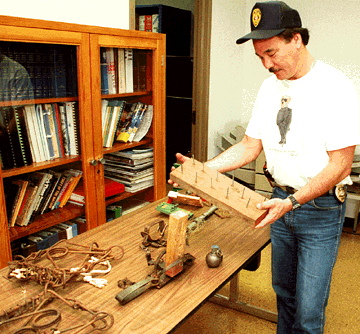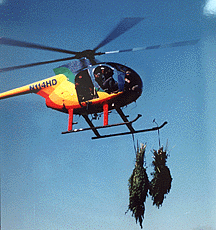
Lt. Chad Fuki, vice commander of the Hilo Police Department,
shows booby traps used by pot growers on the Big Island.
Photo by Ken Sakamoto, Star-Bulletin

Lt. Chad Fuki, vice commander of the Hilo Police Department,
shows booby traps used by pot growers on the Big Island.
Photo by Ken Sakamoto, Star-Bulletin
By Joan Conrow and Jim Witty
Star-Bulletin
Back then, local vice squads teamed with the National Guard to rid public and private lands of the weed.
 By 1985, the state Department of Land and Natural Resources had joined the war on pakalolo, and two years later Hawaii moved into year-round eradication with the intensive Operation Sweep. But all that manpower and money wasn't enough, according to a 1989 report by former state Attorney General Warren Price.
By 1985, the state Department of Land and Natural Resources had joined the war on pakalolo, and two years later Hawaii moved into year-round eradication with the intensive Operation Sweep. But all that manpower and money wasn't enough, according to a 1989 report by former state Attorney General Warren Price.
"The only problem with the eradication effort in Hawaii is that it is costing over $1 million per year and it is not apparently reducing, much less eliminating, the marijuana industry in Hawaii, nor is there any evidence to suggest it is reducing local consumption," the report states.
Still the money kept coming, financing an early 1990s acceleration that deepened federal and military involvement. Now critics want an accounting of the program's social and economic costs and a public discussion of whether it's worth the price.
"I would like to see some sort of evaluation of it," said Big Island Councilman John Ray. "I'm not saying I want more pot around, but I'm concerned about the possible effect of crystal meth and ... more aggressive drugs."
In 1995, the state and Drug Enforcement Administration reported spending $832,573 on marijuana eradication, down from $1.1 million in 1994 and about $1.5 million in 1991. But the figures do not include grant money or county funds - salaries, overtime, meals, aircraft, equipment maintenance and administration - to support the program.
Nor do they include costs incurred by government agencies that have aided the eradication effort, including the Army, Navy and Air Force, U.S. Customs, Bureau of Alcohol, Tobacco and Firearms, U.S. Postal inspectors, Internal Revenue Service, Immigration and Naturalization Service, U.S. Coast Guard, National Park Service, FBI, Office of the U.S. attorney, U.S. marshal's office, National Guard, local and federal prosecutors and the state attorney general.
James White, a University of Hawaii researcher given the task last year of tabulating the cost of Hawaii's drug program for the state Substance Abuse Task Force, said it would be "almost impossible" to ferret out the price tag of the eradication program.
Agencies often do not separate their expenses by drug type, and employees and equipment may share duties. Some state agencies failed to provide any data, White said, and the FBI still has not responded to his year-old request under the Freedom of Information Act.
The DEA, which coordinates and heavily funds Hawaii's eradication program, at first turned down the Star-Bulletin's request for budget data, although local Special Agent Bob Aiu acknowledged it was public information.
"There are people out there who want to use this funding against us," Aiu said. "The figures are there, but we don't want it publicized."
U.S. Sen. Daniel Inouye later obtained the DEA marijuana eradication budget for Hawaii, which showed expenditures of about $3.7 million between 1990 and 1996.
The Washington DEA office also later released the information in response to a Freedom of Information request.
State Rep. David Tarnas of the Big Island said he would like openness and accountability in costs. "We shouldn't have to bang the door down to get the budget," he said. "It doesn't instill trust."
Other Hawaii County lawmakers want to know the program's real costs - including the fiscal impact of eradication on the Big Island economy. Some have started asking whether the money should be diverted to fight drugs that cause more serious health and social problems.
Big Island Councilman James Arakaki advocated using eradication funds to clean out cocaine- and "ice"-ridden neighborhoods in Hilo, and joined Ray and Council Chairwoman Keiko Bonk in calling for a program review.
But that's not an option, say law enforcement officials.
"These Council guys think the money can be diverted to other drugs," noted Big Island police Capt. Chad Fukui.
"It can't. The department has other grants for eradicating and to curtail the hard-drug problem. The grants are restricted."
Said Councilman Ray: "We tend to automatically take the money because it's federal, but it should be the role of lawmakers, not the police department, in setting this policy."
But the lucrative practice, designed to punish and deter criminals, is not without critics.
A Kauai case, in which Brian Lentz lost his Kilauea land and home in federal civil proceedings this year even though he was not convicted of selling marijuana from the home, drew a spate of letters and editorials in local newspapers from those who feared government was going too far.
Police said they found 31/2 pounds of marijuana in a 1992 raid on Lentz's house, after he allegedly sold five ounces of marijuana to an informant from the home.
"One of the problems with forfeiture is it has nothing to do with a criminal conviction," said Hilo attorney Chris Yuen, who argued successfully before the U.S. Supreme Court that hearings should be required before property is seized. "The amazing thing is that it can be imposed on an innocent person."
Forty to 45 homes have been seized since 1988, according to a DEA spokesman.
Gary D. Moniz, acting chief of the state's Division of Conservation Resources and Enforcement, said forfeiture laws have led to increased marijuana growth on public lands, where about 75 percent of the crop is grown.
But eradication operations allow officers to fly over remote public lands that otherwise would be unpatrolled, he said.
They've also reduced the number of growers who clear large patches of pristine native forest for their pot plants and leave behind pest plant seeds, chemical growing aids, plastic, batteries, garbage and human waste, Moniz said.
State airport officials acknowledged that military and Green Harvest flights account for the bulk of aircraft noise complaints in the state.
But law enforcement authorities claim they're getting a bum rap.

"We think we're getting blamed for what the tour helicopters are doing."
Other citizens are concerned about the militarization of the program.
Top-secret Operation Wipeout used military spying techniques to photograph the state for possible growing sites, and Green Berets and Army Special Forces have helped train local officers.
Tarnas and Ray said residents are reluctant to question or criticize the program for fear of being branded drug advocates or users.
Police said they feel besieged by a vocal minority of pot proponents trying to turn the tide.
"(Growers) can tell you until they're blue in the face that they aren't hardened criminals," Aiu said. "But they are."
He said 90 percent are heavily armed and employ all manner of booby traps in their patches, aimed at killing, maiming or otherwise discouraging interlopers. Pungi sticks, crude firing mechanisms designed for use with shotgun shells, and spike-toothed weapons have been confiscated from marijuana patches around the state, officials said.
University of Hawaii drug researchers say they have uncovered no accounts of people killed or injured in the back country by growers' anti-theft devices.
But police recall at least one instance where a man who claimed he was hiking in a Big Island forest was injured by an exploding booby trap.
Police also say marijuana is a bane to society.
"If you talk to law enforcement people about when marijuana was a bad problem, ask them how many homes it broke up," said Fukui. "The bottom line is: Would you let your kids smoke it?"
In the end, however, economics - and not social issues - likely will determine the fate of Hawaii's two-decade effort to halt marijuana cultivation. The state has slashed its eradication budget nearly in half for each of the past two years, county officials are taking a hard look at the program, and federal "drug war" funds are declining.
"The goal of a drug-free Hawaii is not do-able," Tarnas said. "We need to recognize there's a difference between substance use and abuse, and focus on reducing abuse."